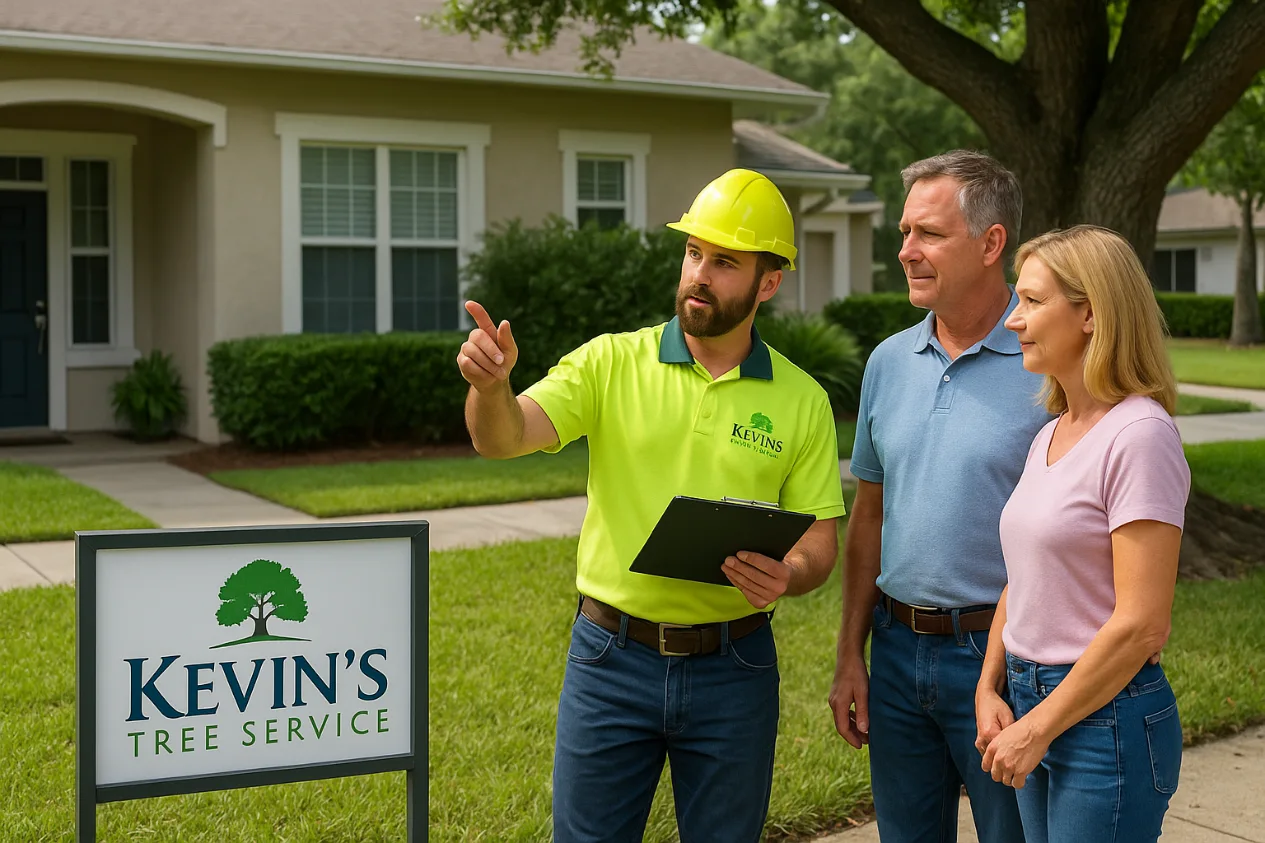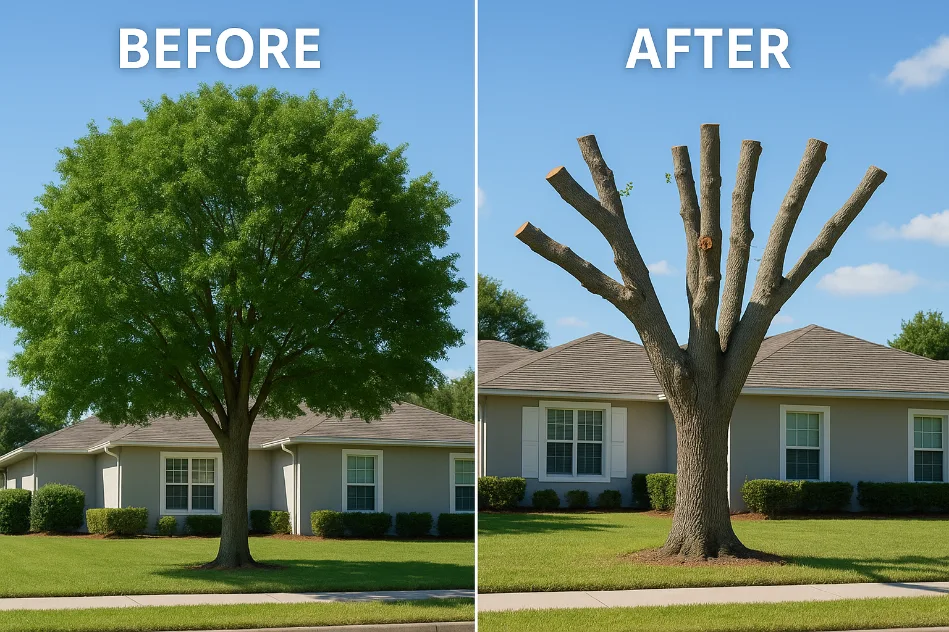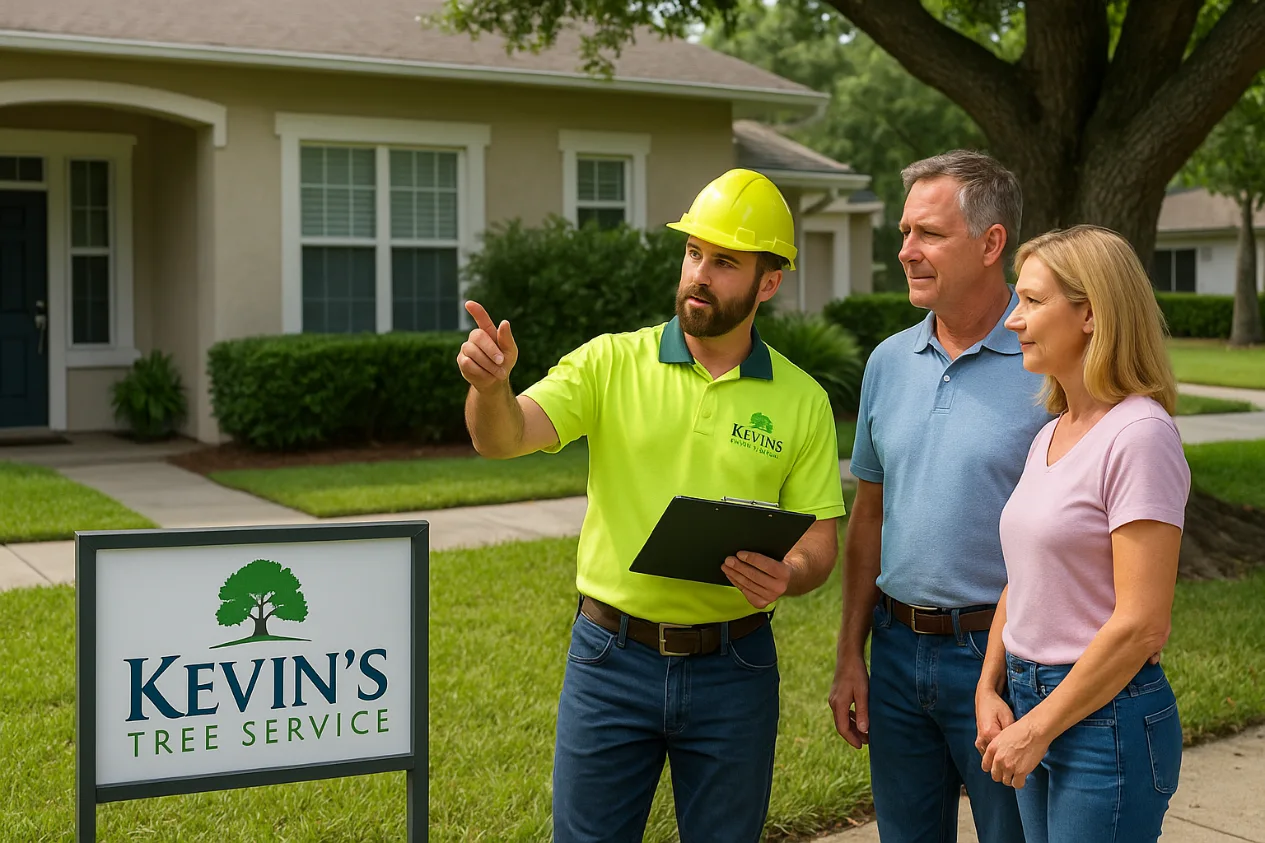Certified Arborist in Orlando, FL – Expert Tree Care & Consulting
Work with an ISA Certified Arborist Orlando homeowners trust for unbiased advice, tree health diagnostics, risk assessments, and pruning plans that protect people and property.
Why Hire a Certified Arborist in Orlando?

Central Florida trees face intense sun, summer downpours, tropical storm winds, compacted sandy soils, and irrigation patterns that swing from droughty to saturated. An experienced certified arborist brings an evidence-based approach to tree care that balances safety, health, and aesthetics. We look beyond “just trimming” to the structure of the tree, the quality of old pruning cuts, the history of the site, and the targets below. You’ll get clear explanations in plain language and a practical plan that protects people, property, and the long-term value of your landscape.
An Orlando certified arborist evaluates species characteristics (live oak vs. laurel oak vs. pine), crown architecture, load distribution, attachment quality, decay indicators, root flare visibility, soil texture, and irrigation zones. We then recommend interventions that follow ANSI A300 standards: each cut has a purpose, timing is considered, and wound size is minimized. The outcome isn’t “maximum removal,” it’s a safer, healthier tree that performs better in wind while preserving shade, beauty, and habitat benefits.
Arborist Services for Orlando Trees
We provide a complete set of arborist services Orlando homeowners and property managers rely on—single trees or comprehensive portfolios. Typical services include:
- Tree health diagnostics: Identify decline, pests, disease, nutrient or soil issues; check trunk flare depth, mulch quality, and irrigation coverage; recommend corrections.
- Risk assessments: Inspect for structural defects, weak attachments, over-extended limbs, basal decay, and impacts to targets; prioritize mitigation by actual risk.
- Pruning plans (ANSI A300): Objectives-based pruning—structural training, selective thinning, clearance pruning, weight reduction, and deadwood removal.
- Palm pruning & care: Species-appropriate palm work for Sabal, Queen, and Date palms; remove dead/dying fronds and fruit stalks without over-lifting.
- Young tree training: Shape future structure early to avoid big corrective cuts later; establish a dominant leader and good branch spacing.
- Construction & root-zone protection: Define tree protection zones, access routes, and soil protection so valuable trees survive nearby work.
- Soil, irrigation & mulch guidance: Deep but infrequent watering, proper mulch depth (clear of trunk flare), and organic amendments where appropriate.
- Storm readiness & recovery: Pre-storm canopy management to reduce wind sail; post-event triage and restoration pruning using correct cut placement.
- Permits guidance: When removal is warranted, we can advise on documentation and provide written assessments on request.
Benefits of an Orlando Certified Arborist
Working with a credentialed pro means every recommendation maps to a goal—safety, health, shade, or clearance—and every cut follows best practice. Benefits include:
- Safety: Identify high-priority hazards and address them proportionally, not with blanket over-pruning.
- Longevity: Preserve leaf area and structure so trees remain vigorous and resilient.
- Better performance in wind: Reduce end-weight and improve attachment without stripping the interior.
- Lower lifetime costs: A planned pruning cycle (often 12–24 months) reduces emergency calls and reactive work.
- Curb appeal: Cleaner lines, better light penetration, and less debris on roofs, gutters, and pool screens.
Certified Arborist vs. Regular Tree Service in Orlando

Any crew can cut; results vary. A certified arborist uses diagnostics, standards, and clear objectives. We avoid topping and lion’s-tailing because these create long-term problems—weak sprouts, sunscald, and unnecessary decay. Instead we use targeted reduction and selective thinning to lower wind sail while protecting structure and tree health.
When to Call an Orlando Certified Arborist
- Deadwood over roofs or walkways, or storm-damaged limbs near targets
- Dense canopies clogging gutters and pool enclosures after wind and rain
- Surface roots, mower damage, or grade changes around the trunk flare
- Large trees close to structures or utilities where clearance matters
- New construction, driveway, or pool work planned near critical roots
- You’re unsure whether pruning or removal is the better option
Our Arborist Process

- Listen & Inspect: Discuss your goals (safety, shade, views, clearance). Inspect species, structure, history, and site conditions.
- Diagnose & Prioritize: Document defects, occupancy of the area beneath, and environmental stressors; rank actions by risk and value.
- Standards-Based Plan: Recommend ANSI A300 objectives (structural pruning, reduction, deadwood removal) or preservation/mitigation steps.
- Estimate & Scheduling: Provide a clear scope with line-item options; phase multi-tree work to reduce mobilizations where possible.
- Careful Execution: Ground protection and modern rigging to safeguard turf and hardscapes; respectful cleanups every time.
- Follow-Up & Care: Simple guidance on irrigation, mulch, and re-inspection intervals to keep trees performing well.
Some sites need minimal work now and a re-check later; others benefit from a two-phase plan. You’ll always get practical, budget-aware options.
Species-Aware Guidance for Orlando
Recommendations vary by species and site. A few common scenarios we see around Orlando neighborhoods:
- Live & laurel oaks: Subordinate competing leaders, reduce end-weight on overextended limbs, remove hazardous deadwood, and avoid flush cuts.
- Southern magnolia: Selective thinning for light and shape while maintaining strong central structure.
- Crape myrtle: Correct “crape murder” with reductions at proper laterals; remove crossing branches to prevent wounds and rubbing.
- Palms: Remove only dead/dying fronds and fruit stalks; maintain appropriate canopy depth for species.
- Pines: Focus on hazard reduction near targets; monitor after strong wind events.
Healthy trees begin below ground. Keep mulch off the trunk flare, avoid burying the flare with soil, water slowly and deeply (less often), and protect roots from trenching and compaction during projects.
Storm Readiness for Orlando Properties
Storm planning isn’t about removing the most wood—it’s about improving structure so trees withstand wind better. Strategic reduction and selective thinning can lower wind sail while maintaining strength. We also address conflicts with rooflines and pool screens and remove hazardous deadwood before it becomes a projectile. After storms, we prioritize hazardous failures and restore structure with correct cuts.
Consulting, Documentation & Permits Guidance
Need documentation for an HOA or local review? We can provide written assessments on request and advise what reviewers typically expect. If removal is the safest choice, we’ll outline why and include photos or notes to support an application. If pruning can reasonably reduce risk, we’ll explain that path as well.
Pricing & Scheduling
Pricing reflects scope, access, equipment needs, and debris handling. You’ll receive a clear written estimate and options to phase work or bundle services like stump grinding. For larger properties, a maintenance plan often reduces total cost over time.
Related Services & Helpful Resources
- Tree Trimming in Orlando — structural pruning, thinning, and safe clearances.
- Tree Removal in Orlando — safe, insured removals with careful cleanups.
- Stump Grinding — grind below grade, backfill, and rake smooth.
Recommended reading:
Real-World Orlando Scenarios & How We Help
Heritage live oak over a 1950s roof: The owner wanted shade preserved but feared storm damage. We mapped targets and wind exposure, reduced end-weight on select leaders, removed hazardous deadwood, and installed ground protection mats to avoid rutting. The result: a stronger structure, better roof clearance, and the same beautiful canopy silhouette.
Pool enclosure and queen palms: Heavy fruit stalks and drooping fronds were staining the deck and tearing screens. We scheduled seasonal palm pruning to remove fruit stalks before drop, maintained appropriate canopy depth, and set a simple irrigation schedule to reduce stress and mineral staining.
New driveway near a laurel oak: The homeowner planned a wider drive that crossed major roots. We adjusted the layout slightly, defined a root protection zone, and recommended permeable base in the critical area. The tree kept its stability, and the project stayed on schedule.
HOA streetscape with mixed species: Competing objectives—visibility for signage, shade for sidewalks, and minimal storm debris. We established species-specific pruning intervals, standardized clearance heights, and provided short guidance sheets so future landscapers maintain to the same standard.
Common Mistakes to Avoid
- Topping or lion’s-tailing: These practices create weak regrowth and long-term problems. Choose reduction and structural pruning instead.
- Burying the trunk flare: Soil or mulch piled against the trunk invites decay and girdling roots. Keep the flare visible.
- Over-watering: Frequent shallow watering weakens roots. Water deeply but less often to encourage depth and resilience.
- Ignoring early signs: Small cracks, fungal conks, or a subtle lean can signal bigger issues. Early arborist input prevents bigger bills later.
Working with HOAs, Property Managers & Builders
We regularly coordinate with managers and boards to balance aesthetics, safety, and budgets. For communities and commercial sites, we can conduct a portfolio assessment and set practical, phased plans that reduce call-outs and emergency costs. For builders, we define access routes and protection zones so equipment can move without compromising high-value trees. Documentation—photos, simple maps, and written recommendations—keeps everyone aligned and approvals smooth.
Sustainable Tree Care
Good arboriculture is conservative by design: it preserves tree benefits—shade, cooling, habitat, stormwater interception—while keeping people safe. Our recommendations aim to maximize benefits with the least intervention necessary. We favor timed, objective-driven pruning over reactionary cycles, choose debris handling that fits your property, and suggest soil improvements that reduce irrigation waste and runoff.
Certified Arborist FAQs
Are you ISA certified?
Yes, our arborist is ISA-credentialed and follows ANSI A300 pruning standards.
Can you tell if my tree can be saved?
We’ll diagnose health, structure, and site conditions and provide honest options, including preservation when feasible.
Do you help with tree removal permits?
Yes, we advise on local requirements and provide documentation when needed.
Will you recommend removal if it’s safer?
If the tree is unsound or poorly placed, we’ll explain why removal is warranted and perform it safely.
Do you provide written plans?
Yes — scope, objectives, and timelines so you know exactly what will be done.
How often should I schedule pruning?
Most properties benefit from a 12–24 month cycle depending on species, exposure, and clearance needs.
What is an ISA Certified Arborist?
A credentialed professional who demonstrates knowledge of tree biology, pruning, safety, and ethics through examination and continuing education.
Do you follow ANSI A300?
Yes. Our pruning follows ANSI A300 — no topping or flush cuts, and we preserve structure and branch collars.
Can you advise on storm preparation?
Absolutely. We identify defects, recommend corrective pruning, and schedule maintenance before hurricane season.
Talk with an ISA Certified Arborist
Get expert guidance for pruning, removals, and risk reduction on your property.
